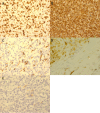High-grade undifferentiated small round cell sarcoma with t(4;19)(q35;q13.1) CIC-DUX4 fusion: emerging entities of soft tissue tumors with unique histopathologic features--a case report and literature review
- PMID: 25683183
- PMCID: PMC4338805
- DOI: 10.12659/AJCR.892551
High-grade undifferentiated small round cell sarcoma with t(4;19)(q35;q13.1) CIC-DUX4 fusion: emerging entities of soft tissue tumors with unique histopathologic features--a case report and literature review
Abstract
Background: A subset of undifferentiated small round cell sarcomas (USRCSs) is currently being recognized as emerging entities with unique gene fusions: CIC-DUX4 (the area of focus in this article), BCOR-CCNB3, or CIC-FOXO4 gene fusions. CIC-DUX4 and CIC-FOXO4 fusions have been reported in soft tissue tumors, while BCOR-CCNB3 fusion with an X chromosomal inversion was described in both bone and soft tissue tumors. CIC-DUX4 fusion can either harbor t(4;19)(q35;q13.1) or t(10;19)(q26.3;q13), while t(4;19)(q35;q13.1) is reported more commonly.
Case report: The aim of this study is to share a new case report of a 36-year-old woman who had a rapidly growing mass in her right upper thigh, which was found to be an undifferentiated small round cell sarcoma with t(4;19)(q35;q13.1) CIC-DUX4 fusion was confirmed by cytogenetic testing. Combined modality treatment with surgery, radiation, and chemotherapy was used and achieved a good response. A review of the literature of the reported cases with CIC-DUX4 fusions including both t(4;19) and t(10;19) translocations revealed a total of 44 cases reported. Out of these 44 cases, 33 showed t(4;19)(q35;q13.1) translocation compared to 11 cases with t(10;19)(q26.3;q13).
Conclusions: Undifferentiated small round cell sarcomas are aggressive tumors. Their treatment includes surgery, chemotherapy, and radiation. Resistance to chemotherapy is common. Lung and brain are common sites of metastasis, with associated poor prognosis. Generally, median survival is less than 2 years. Newer techniques have been developed recently which helped identify a subset of previously unclassifiable sarcomas, with promising prognostic value.
Figures




References
-
- Fletcher CDM, Bridge JA, Hogendoorn PCW, Mertens F. World Health Organization classification of tumours of soft tissue and bone. 4th ed. Lyon: International Agency for Research on Cancer (IARC); 2013.
-
- Pierron G, Tirode F, Lucchesi C, et al. A new subtype of bone sarcoma defined by BCOR-CCNB3 gene fusion. Nature Genetics. 2012;44:461–66. - PubMed
-
- Sugita S, Yasuhito A, Akiko T, et al. A Novel CIC-FOXO4 Gene Fusion in Undifferentiated Small Round Cell Sarcoma: A Genetically Distinct Variant of Ewing-like Sarcoma. Am J Surg Pathol. 2014;38(11):1571–76. - PubMed
-
- Richkind KE, Romansky SG, Finklestein JZ. t(4;19)(q35;q13.1): a recurrent change in primitive mesenchymal tumors? Cancer Genet Cytogenet. 1996;87:71–74. - PubMed
Publication types
MeSH terms
Substances
LinkOut - more resources
Full Text Sources
Other Literature Sources
Research Materials
Miscellaneous

